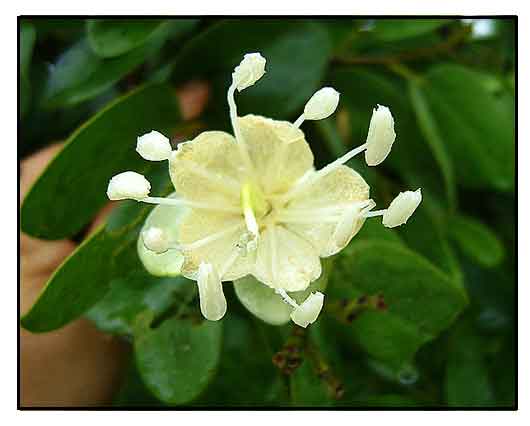 General info General info
- Hymenaea is a genus of plants in the legume family Fabaceae.
- The genus was name by Linnaeus in 1753 in Species Plantarum for Hymenaios, the Greek god of marriage ceremonies. (20)
- The 'stinking toe" names refers to the unpleasant odor of the edible pulp of its seed pods.
Botany
Jatoba is an evergreen, medium-sized tree, growing 25 or more meters tall. Bole is 1 meter or more in diameter. Bark is smooth, 2.5 cm or more thick, gray to pinkish brown. Leaves are alternated, bifoliolate, glossy green above, gland dotted. Petiole is 1-2 cm long, petiolules twisted, 2 to 4 mm long, leaflet blade falcate, rarely oblong or obovate, 4-10 cm by 2-5 cm, coriaceous, base asymmetrical and rounded, margin entire, apex short to long acuminate. Inflorescence if terminal, densely corymbose-paniculate, 8 to 15 cm long and wide,. Flowers are large, buds p to 3.5 cm long; open flower 3 cm in diameter; calyx campanulate, 4-merous, gray-green, tube 6 mm long, lobes ovate to elliptical, 15 to 18 mm by 8 mm. Fruit is a compressed cylindrical pod, 8 to 20 cm by 4 to 8 cm, smooth or rough, dark-brown, indehiscent, containing 6 to 12 seeds embedded in pale, yellow, unpleasant smelling fruit flesh. Seed is ellipsoidal, flattened, 2 to 3 cm long, dark red. (In the Philippines large nodules with a rough surface have been observed on the roots.) (2)
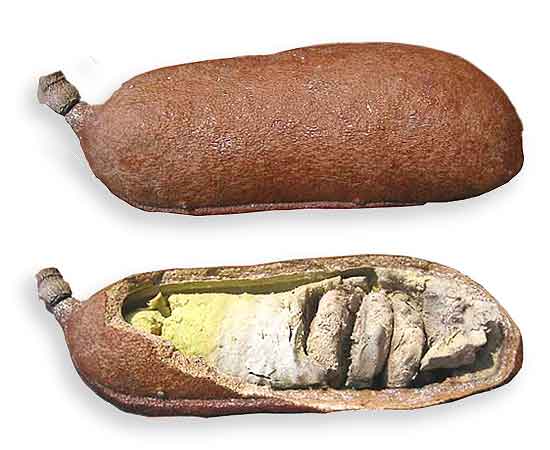 Distribution Distribution
- Introduced.
- Native range to Belize, Bolivia, Brazil North, Brazil Northeast, Brazil South, Brazil Southeast, Brazil West-Central, Colombia, Costa Rica, Cuba, Dominican Republic, El Salvador, French Guiana, Guatemala, Guyana, Haiti, Honduras, Jamaica, Leeward Is., Mexico Central, Mexico Gulf, Mexico Northwest, Mexico Southeast, Mexico Southwest, Nicaragua, Panamá, Paraguay, Peru, Puerto Rico, Suriname, Trinidad-Tobago, Venezuela, Venezuelan Antilles, Windward Is. (1)
- Also introduced into Benin, Borneo, China Southeast, Congo, Guinea, Guinea-Bissau, Ivory Coast, Jawa, Kenya, Madagascar, Malaya, Sri Lanka, Taiwan, Uganda, Zimbabwe. (1)
Constituents
- Dried fruit pulp per 100 g yields: 309 calories, 14.6 g water, 5.9 g protein, 2.2 g fat, 75.3 g total carbohydrate, 13.4 g fiber, 2.0 g ash, 28 mg calcium, 143 mg phosphorus, 3.2 mg iron, trace of ß-carotene equivalent, 0.23 mg thiamine, 0.14 mg riboflavin, 4.1 mg niacin, and 11 mg ascorbic acid. (4)
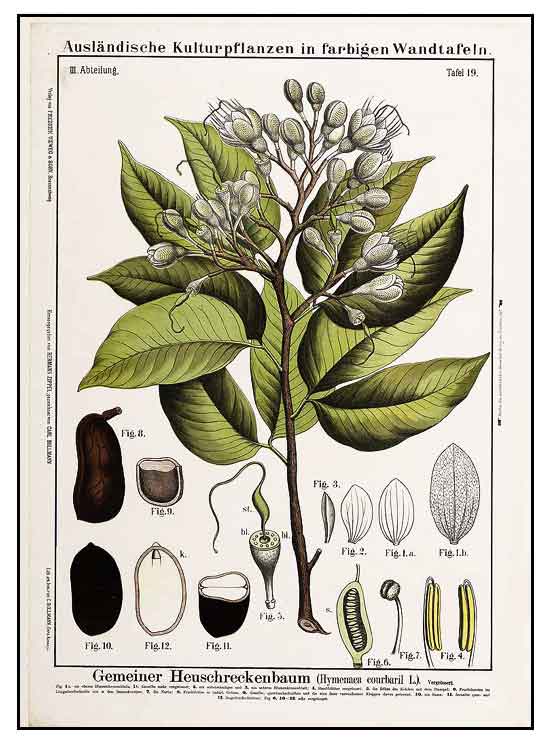 - Phytoconstituents include alpha-copaene, alpha-cubebene, alpha-himachalene, alpha-humulene, alpha-muurolene, alpha-selinene, astilibin, beta-bisabolene, beta-bourbonene, beta-copaene, beta-cubebene, beta-gurjunene, ß-humulene, ß-selinene, ß-sitosterol, calarene, carboxylic acids, caryophyllene, catechins, clerodane diterpenes, communic acids, copacamphene, copalic acid, cubebene, cyclosativene, cyperene, delta-cadinene, gamma-muurolene, gamma-cadinene, halimadienoic acids, heptasaccharides, kovalenic acid, labdadiene acids, octasaccharides, oligosaccharides, ozic acids, polysaccharides, selinenes, and taxifolin. (6) - Phytoconstituents include alpha-copaene, alpha-cubebene, alpha-himachalene, alpha-humulene, alpha-muurolene, alpha-selinene, astilibin, beta-bisabolene, beta-bourbonene, beta-copaene, beta-cubebene, beta-gurjunene, ß-humulene, ß-selinene, ß-sitosterol, calarene, carboxylic acids, caryophyllene, catechins, clerodane diterpenes, communic acids, copacamphene, copalic acid, cubebene, cyclosativene, cyperene, delta-cadinene, gamma-muurolene, gamma-cadinene, halimadienoic acids, heptasaccharides, kovalenic acid, labdadiene acids, octasaccharides, oligosaccharides, ozic acids, polysaccharides, selinenes, and taxifolin. (6)
- Study of seeds isolated two new biscoumarins from H. courbaril, namely:. hymenain 7-O-b-glucopyranosyl- (1'''--> 2'')-O-a-apiofuranosyl-(1''''--> 2''')-O-α-galactopyranoside (1) and hymenain 7-O-b-glucopyr- anosyl-(1''' --> 2'')-O-α-apiofuranoside (2). (14)
- Study of H. courbaril essential oil showed main compounds of trans-caryophyllene (46.24%), oxide caryophyllene (14.67%) and α-humulene (9.19%). (see study below) (16)
- GC and GC-MS study of pods ripe fruit for essential oil yielded
main constituents of sesquiterpene α-copaene (11.1%), spathulenol (10.1%), and ß-selinene (8.2%) while unripe fruits yielded germacrene-D (31.9%), ß-caryophyllene (27.1%) and bicyclogermacrene (6.5%). (see study below) (17)
- Bioactivity-guided fractionation of methanol extract yielded three new diterpenoids: (13R)-13-hydroxy-1(10),14-ent-halimadien-18-oic acid (1), (2S,13R)-2,13-dihydroxy-1(10),14-ent-halimadien-18-oic acid (2), and (13R)-2-oxo-13-hydroxy-1(10),14-ent-halimadien-18-oic acid (3). (see study below) (18)
- Study of germinated seeds of H. courbaril var. stilbocarpa isolated a new biscoumarin (7-hydroxy-6,6′-dimethoxy-3,7′-dicoumarinyl ether), named hymenain (1) and the known biscoumarin ipomopsin (2). (see study below) (31)
-
Fractionation of resin by silica gel open column chromatography afforded two compounds: (5S,9S,10R)-ent-labd-8(17)-en-15 ethyl acetate (1) and copalic acid [5-(2-methylene-5,5,8atrimethyl-(1R,4aR,8aR)-decahydronaphthalen-1-yl)-3-methylpent-2E-enoic acid] (2). (33)
Properties
- All parts contain a resin..
- Even when the tree's life cycle is completed and the tree dies, the wood of the Jatoba tree does not rot, a property that underscores therapeutic potential.
(13)
- Considered anodyne, antiseptic, astringent, laxative, pectoral, purgative, sedative, stimulant, tonic, vermifuge. (4)
- Studies have suggested antifungal, antibacterial, anti-inflammatory, lipid peroxidation inhibition,
antioxidant, myorelaxant, larvicidal, antigenotoxicity, antimelanoma, antiproliferative, apoptotic, antibiofilm, molluscicidal, antinociceptive properties.
Parts used
Bark, leaves, fruit.
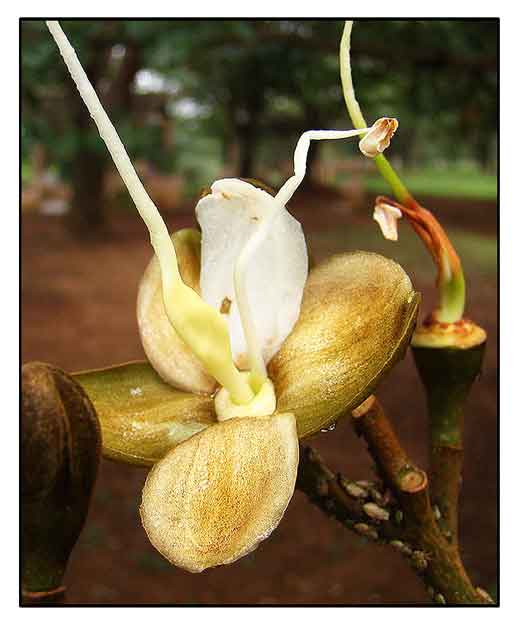 Uses Uses
Edibility
- Fruit is edible, raw or cooked. Used for making custards and ice-cream.
-
Pulp around the seed is edible, although with a peculiar or unpleasant smell. (2)
- The fruit, also known as locust, was a major food for indigenous peoples.
- In Brazil, fruit pulp used as carbohydrate source for making alcoholic beverage.
- In South America, the pulp is dried and powdered for making snacks; also, mixed with water to prepare a drink called 'atole.' (19)
Folkloric
- Bark decoction used as respiratory and urinary tonic by indigenous people of the Amazon basin. (3)
- In the Amazon, used to boost sexual and sportive performance.
- Decoction used to treat cough, back pains, stomach problems. Externally, use for athlete's foot. (3)
- Leaves used to treat cystitis, hepatitis, prostatitis and cough. Resin and sap used for treating fresh wounds. (3)
- Fruit is a mild laxative;
- In traditional medicine in Panama,
fruit used to treat mouth ulcers. Leaves and wood used for treatment of diabetes. (6)
-Used for beri-beri, blenorrhagia, bronchitis, catarrh, cultists, emphysema. Bark infusion used as depurative stomachic in exanthema. Smoke from rosin used for headaches and rheumatism. (4)
- In traditional Brazilian folk medicine, used for anemia, kidney problems, sore throat, bronchitis and asthma
(15)
- In Suriname, infusion of stem bark used for treatment of hypertension.
(19)
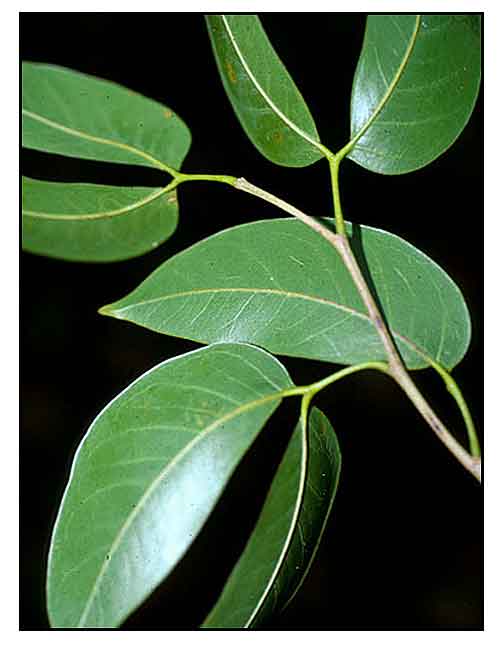 Others Others
- Wood: Wood is valuable and resembles mahogany; hard, durable, used for construction, door and window frames, furnitures, ship building, paneling and parquet flooring. Bark is so thick it us used by Indians for making canoes. (2) Even when the tree's life cycle is completed and the tree dies, the wood of the Jatoba tree does not rot. (13)
- Fuel: Wood can be used as firewood and the pods for alcohol generation.
- Tannin: Bark yields tannin.
- Agroforestry: Used as nitrogen fixing tree to rehabilitate degraded and marginal soils. (2)
- Honey: Flowers attract beens and used for honey production. (2)
- Resin: A source of copal. Brazil is the main source of the resin. International trade is reportedly small or negligible. "Recent copal" obtained from tapping is exported to India and China, where it is made into coarse varnish. (2) Sticky resin called "anime" with its pleasant fragrance can be used for making incense, perfume, and varnish. Also, the indigenous peoples of the Amazon have used the resin for centuries to preserve the colors of their pottery. (19)
- Crafts: In El Salvador, hard reddish-brown seeds are used by artisans to create jewelry and miniature paintings on the inside surface of cut seeds. (5)
Studies
• Biochemical Analysis Under Heat Stress: Study investigated the differential expression of proteins and lipids produced by the tree under heat stress conditions. Several volatiles, isoprene, 2-methyl butanenitrile, ß-ocimene and a number of sesquiterpenes were produced under heat stress. Heat stress proteins, including heat shock proteins, histone proteins, oxygen evolving complex, and photosynthetic proteins were believed to play key roles in imparting thermotolerance. (7)
• Antifungal / Cytotoxicity / Fisetin / Fresh Xylem Sap: Study evaluated the cytotoxicity of fresh xylem sap of Hymenaea courbaril and fisetin against 3T3-A31 cells of Balb/c and for bioactivity against fungi Cryptococcus neoformans species complex and dermatophytes. Fisetin was filtered from the fresh xylem sap. The filtrate was a moisture of fistinediol, fustin, 3-O-methyl-2,3-trans-fustin and taxifolin. Results showed in vitro antifungal activity and low toxicity on animal cells. The xylem sap inhibited the growth of dermatophytes and C. neoformans with MIC of <256 µg/mL while fisetin showed MIC <128 µg/mL. Fisetine showed lower toxicity IC50 of 158 µg/ml compared to fresh xylem sap IC50 109 µg/ml. (8)
• Terpenoids / COX-2 and Lipid Peroxidation Enzyme Inhibition / Fruits: Study of fruit powder yielded sucrose and linolenic acid as major compounds. Pods yielded labdane diterpenoids. Total amounts of the terpenoids in the fruit was about 0.1% (w/w) of the dried fruit. Compound 3 and 4 showed selective COX-2 enzyme inhibition. Compounds 1, 2 and 5 inhibited lipid peroxidation by 46%, 48%, and 75%, respectively at 100 ppm. (see constituents above) (9)
• Antimicrobial / Fruit: Study evaluated the antimicrobial activity of H. courbaril against four bacteria, E. coli, S. aureus, B. subtilis and P. aeruginosa and fungi C. albicans and Saccharomyces cerevisiae and A. niger. The dichloromethane extract showed antimicrobial activity against Staphylococcus aureus with 1.47% inhibition. No inhibitory activity was seen against fungi. (10)
• Ultrasound-Assisted Extraction of Polyphenols / Increase Antioxidant Capacity / Bark: Study reports on the ultrasound assisted extraction of polphenols from bark. Water with S/F of 20 was the best solvent for extraction of phenolic compounds. Results showed a statistically significant (p<0.005) effect with approximately 15% increase in total phenolic compounds content when using maximum power. DPPH analysis confirmed the high antioxidant capacity of the ultrasound extracts. (11)
• Synergism with S. adstringens against -Assisted Extraction of Polyphenols / Increase Antioxidant Capacity / Bark: Study investigated the in vitro antimicrobial activities of H. courbaril and Stryphnodendron adstringens against clinical bacterial isolated. The crude extracts of both vegetal species showed bacteriostatic activity against almost all bacteria evaluated, with MIC ranging from 135-1250 µg/ml. The combination exhibited potent synergistic antimicrobial activity with MICs of 31.25 µg/ml against Acinetobacter baumannii, E. coli, and S. aureus. The synergism against resistant bacteria suggests potential for the development of new drugs. (12)
• Glycosylated Biscoumarins / Seeds: Study of seeds isolated two new biscoumarins from H. courbaril seeds. This was the first study for the purpose of identifying seed molecules. (see constituents above) (14)
• Myorelaxant Activity / Antioxidant / Anti-Inflammatory / Astilbin / Stem Bark: Astilbin is a flavonoid isolated from the bioactive ethyl acetate fraction of stem bark. Whole extract and some fractions strongly scavenged DPPH radical. The extract exhibited myorelaxant activity on rat trachea, with the EAF the most efficient fraction. Astilbin may be partly responsible for the myorelaxant effect of EAF. Results suggest potential antioxidant, myorelaxant and anti-inflammatory actions for the treatment of inflammatory airway disease. (15)
• Anti-Inflammatory on Pterygium Fibroblasts / Essential Oil: Study evaluated the anti-inflammatory effects of essential oil in pterygium genesis. Primary cultures of pterygium fibroblasts were exposed to H. courbaril essential oil. MTT test showed α-humulene, trans-caryophyllene and both together showed cytotoxic effect in concentration of 0.5 to 5 µM. The trans-caryophyllene compound from essential oil at 25 µM showed significant anti-inflammatory effect on IL-6 production of pterygium fibroblasts. Results suggest a potential alternative adjuvant agent in the treatment of pterygium. (see constituents above) (16)
• Larvicidal / Ae. aegypti / Essential Oil of Fruit Peel: GC-MS study analyzed the essential oil from peel of ripe and unripe fruits. Tested against Aedes aegypti larvae, the essential oil shewed LC50 values of 14.8 ± 0.4 µg/ml and 28.4 ± 0.3 µg/ml for ripe and unripe fruit pod oils, respectively. (see constituents above) (17)
• Diterpenoids / Weak Cytotoxicity. to Human Ovarian Cell Line and Mutant Yeast Strain: Study of methanol extract yielded three new diterpenoids. Compound 1 showed weak cytotoxicity towards 1138 mutant yeast strain and the A2780 human ovarian cancer cell line. (see constituents above) (18)
above) (17)
• Wound Healing / Antioxidant / Sap: Study evaluated the effect of Hymenaea courbaril sap extract and its wound healing effect in Swiss mice with induced back injury and treated with a formulation containing 2% sap extract, extracted with ethyl acetate. Antioxidant potential of the sap was studied sing DPPH, anion superoxide radical tests, phenol and flavonoid content, proliferation assay, cell viability and migration. The sap exhibited antioxidant activity, inhibiting production of reactive oxygen species, and promoted cell migration. Results showed wound healing potential attributed to its antioxidant activity. (22)
• Wound Healing / Antioxidant / Sap: Study evaluated the effect of supplementation with Hymenaea courbaril on athletic performance, markers of muscle and liver injury, compared with classical supplement, the monohydrate creatine. Results support the hypothesis that both courbaril and creatine improved physical performance of young adults in explosive-strength exercises. Creatine supplementation increase the stock of creatine and intramuscular phosphocreatine, optimizing ATP synthesis and resynthesis. Courbaril is a potential natural ergogenic resource through its antioxidant properties, which can delay or inhibit the formation of ROS, and improve redox balance and decrease muscle fatigue. The supplementation is not hepatotoxic. While further studies are suggested for effects on body metabolism and testosterone, it is inferred that courbaril extract can be used to improve athletic performance. (23)
• Anti-Melanoma / Genotoxicity / Antioxidant / Seeds: Study evaluated the cytotoxicity, genotoxicity, antigenotoxicity, and antioxidant potentials of hydroethanolic extract of H. courbaril seeds. For cytotoxicity testing, anti-melanoma assay was performed in B16F10 strain cells. The hydroethanolic extract showed antigenotoxic effect and antioxidant activity. Total flavonoid content was 442.25 mg RE/g extract. HPLC-PAD chromatogram showed flavones as majority compound in the extract. The extract also showed dose- and time-dependent cytotoxic activity against B16F10 melanoma cell lines. (24)
• Toxicological Profile / Stem Bark: Study evaluated the toxicological parameters of H. courbaril stem bark hydroalcoholic extract using three cell lines including murine macrophages (RAW 264.7), mouse fibroblast cells (L929), human lung fibroblast (MRC-5) and Salmonella/microsine assay, and in vivo Caenorhabditis elegans model. The extract yielded coumarins, flavonoids, phenolics, tannins, and saponins, and by HPLC analysis, astilbin (AST) was the main component. By DPPH assay, the extract showed potent antioxidant activity with IC50 of 3.12 µg/mL. At 400 and 800 µg/mL concentrations, the extract decreased cell viability. In alkaline comey assay, it was found non-genotoxic. In the Ames test, it showed low mutagenic potential without metabolic activation. Results suggest the extract has low toxicity as evidenced by invitro and mutagenicity assays. (25)
• Antibiofilm / Antimicrobial / Antioxidant / Stem Bark: Study evaluated the antioxidant, antimicrobial, and anti-biofilm potential of nine extracts of H. courbaril. Results showed high phenolic content, mainly in the stem bark. In anti-biofilm analysis, leaf extracts out with comparable inhibition percentages with chloramphenicol of 78.29% and 78.85%, respectively. UPLC-HRMS/MS study of leaves yielded chrysoeriol-7-O-neohesperidoside, isorhamnetin-3-O-glucoside, and 3,7-di-O-methylquercetin. Results showed potential as antioxidant and antimicrobial with anti-film effect. (26)
• Anti-Inflammatory / Antinociceptive / Stem Bark: Study evaluated the anti-inflammatory and antinociceptive actions of ethanolic extract (EE)of Hc stem bark in animal models. The EE
efficiently reduced abdominal contortions induced by acetic acid; time of paw licking in formalin test; paw edema induced by carrageenan and dextran; leukocyte migration after intraperitonea injection of carrageenan and myeloperoxidase expression on peritoneal exudate. The EE also improved histopathological damages in rat paw after carrageenan inflammation, and reduced TNF-α expression. Results suggest intense anti-inflammatory and antinociceptive effects. (27)
• Antimicrobial / Antioxidant / Synergistic Effects of Combination / Fruit Peel and Seed: Study evaluated the in vitro antioxidant and antimicrobial potential of hydroalcoholic extracts from peel and seeds of jatoba fruit and synergistic effect of their combination against pathogenic bacteria. The 80% ethanol fruit seed extract showed greater antioxidant potential and higher phenolic content (5135.61 mg GAE 100 g dry residue than 50% ethanol peel extract (2614 mg GAE 100 g / dry residue). The 70% and 80% ethanol seed extract inhibited most bacteria, especially Pseudomonas aeruginosa, with lowest MIC (1.0 and 8.0 mg/mL) compared to peel extracts. Combination of 70% ethanol extracts of peels and seeds reduced the MICs by about 4 to 32 times against Bacillus cereus, B. subtilis, Enterococcus faecalis, Staphylococcus aureus, P. aeruginosa, and Salmonella enteritidis. Results showed peels and seeds have potential as natural antioxidants and antimicrobials. (28)
• Antiprolieferative / Apoptotic on Prostate Cancer Cell Line / Leaves: Study evaluated leaves extracts from different polarities using MTT cell viability assay to determine cytotoxicity in prostate p53-null cells. GC-MS analysis identified the majority compound as caryophyllene oxide, which induced early and late apoptosis, depolarized mitochondrial membrane. Depolarization of the mitochondrial membrane released pro-apoptotic protein Bax from Bcl-xL. The apoptosis process was caspase-7 activation-dependent. Results suggest caryophyllene oxide is a safe anti-proliferative agent against PC-3 cells, inducing apoptosis with low cytotoxicity towards normal cells. (29)
• Antifungal against Cryptococcus neoformans / Inner Bark: In a study of various crude extracts of medicinal plants, the extract from maceration of inner bark of Hymenaea courbaril was one of four plants that showed antifungal activity against clinical isolates of C. neoformans. (30)
• Antioxidant Biscoumarins / Hymenain and Ipomopsin / Seeds: Study of germinated seeds of H. courbaril var. stilbocarpa isolated a new biscoumarin (7-hydroxy-6,6′-dimethoxy-3,7′-dicoumarinyl ether), named hymenain (1) and the known biscoumarin ipomopsin (2). Hymenain and ipomopsin showed direct free radical scavenging (DPPH) with EC50s of 100 and 300 µM, respectively. (31)
• Trypsin and Papain Inhibitors / Antibacterial / Seeds: Study evaluated crude extract and protein fractions of H. courbaril for presence of trypsin and papain inhibitors and antimicrobial activity against
Vibrio parahemolyticus, S. aureus, and E. coli. Results showed inhibition of trypsin and papain activity, but in different degrees. Fractions Hc030 and Hc3060 only showed antimicrobial activity against V. parahemolyticus, with the Hc3060 fraction showing more effective inhibition of trypsin (100%) than papain (54%). Results suggest a source of bioactive compounds. (32)
• Molluscicidal against Biomphalaria glabrata / Essential Oil of Fruit Peels: In a study for molluscicidal activity of essential oils against Biomphalaria glabrata, H. courbaril yielded germacrene-D as major constituent. The toxicity assay using Artemia salina showed non-toxic LC50 of354.80 mg/L. Molluscicidal assay showed LC50 of 37.34 mg L/LC90 73.24 mg/L. Results suggest potential as a natural molluscicide against snail B. glabrata. (33)
Availability
- Wildcrafted.
- Cultivated.
- Herbal teas, tinctures, capsules, supplements in the cybermarket.
|

![]()





 - Phytoconstituents include alpha-copaene, alpha-cubebene, alpha-himachalene, alpha-humulene, alpha-muurolene, alpha-selinene, astilibin, beta-bisabolene, beta-bourbonene, beta-copaene, beta-cubebene, beta-gurjunene, ß-humulene, ß-selinene, ß-sitosterol, calarene, carboxylic acids, caryophyllene, catechins, clerodane diterpenes, communic acids, copacamphene, copalic acid, cubebene, cyclosativene, cyperene, delta-cadinene, gamma-muurolene, gamma-cadinene, halimadienoic acids, heptasaccharides, kovalenic acid, labdadiene acids, octasaccharides, oligosaccharides, ozic acids, polysaccharides, selinenes, and taxifolin. (
- Phytoconstituents include alpha-copaene, alpha-cubebene, alpha-himachalene, alpha-humulene, alpha-muurolene, alpha-selinene, astilibin, beta-bisabolene, beta-bourbonene, beta-copaene, beta-cubebene, beta-gurjunene, ß-humulene, ß-selinene, ß-sitosterol, calarene, carboxylic acids, caryophyllene, catechins, clerodane diterpenes, communic acids, copacamphene, copalic acid, cubebene, cyclosativene, cyperene, delta-cadinene, gamma-muurolene, gamma-cadinene, halimadienoic acids, heptasaccharides, kovalenic acid, labdadiene acids, octasaccharides, oligosaccharides, ozic acids, polysaccharides, selinenes, and taxifolin. (

